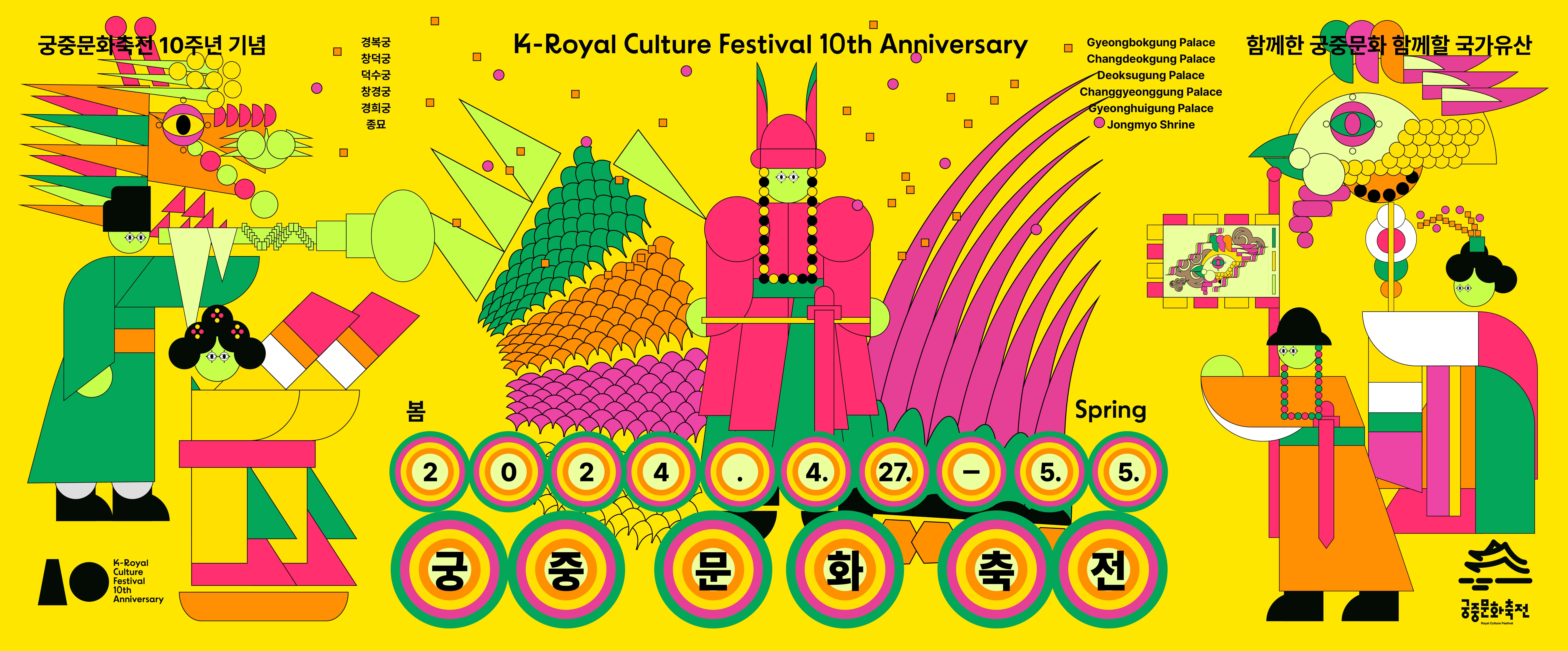PRESS
2024 K-Royal Culture Festival Announcement
- Post Date2024-03-05
- Hits361 Hit
2024 K-Royal Culture Festival

Meet Palaces Today
The Royal Culture Festival is a festival held at the seven major cultural heritage sites in Seoul. The festival venues which have the history of Joseon and the Korean Empire are five palaces, namely Gyeongbokgung Palace, Changdeokgung Palace, Changgyeonggung Palace, Deoksugung Palace, Gyeonghuigung Palace, and Jongmyo Shrine, and Sajikdan Altar. Hosted by the Cultural Heritage Administration and organised by the Korea Cultural Heritage Foundation, the Royal Culture Festival offers a wide range of programs for both Koreans and foreigners to 'Meet Palaces Today'. In spring and autumn, the festival provides cultural and artistic programs such as performances, exhibitions, experiences, and ritual reenactments that reflect the history of the palace and the characteristics of the each palace
hall and venue. The Royal Culture Festival strives to bring more people who love the palaces to experience the charms of the palaces. Also it provides foreign visitors to Korea with the opportunity to participate in dignified and fascinating historical and cultural programs, making itself a special venue for promoting Korean
cultural heritage and Korea's cultural capabilities to the outside world.
2024 10th K-Royal Culture Festival
Period
Spring 2024. 4. 27.(Sat)-5. 5.(Sun) / 9 days
Fall 2024. 10. 9.(Wed)-10. 13.(Fri) / 5 days
Venues
Royal Palaces of Seoul, Jongmyo Shrine, Online
Contact
Website: https://www.chf.or.kr/fest
Youtube: https://www.youtube.com/@K-royalculture
Instagram: @royalculturefestival_official
E-mail: royalculture1@chf.or.kr
Royal Palaces of Seoul
Seoul is a city with a long history and started with Hanyang, the capital of Joseon and the Korean Empire. The cultural heritage that best represents this is the palace where the kings and emperors of Joseon and the Korean Empire ruled the country. The palace is not only a private space for the king but also a public
space for the politics of the country in that it is a space for the king to do politics with his subjects. There are currently five palaces in Seoul, including Gyeongbokgung Palace, Changdeokgung Palace, Changgyeonggung Palace, Deoksugung Palace, and Gyeonghui Palace. Gyeongbokgung Palace is the first palace built among the five palaces. Built in 1395 (the 4th year of King Taejo's reign) to move the capital to Hanyang after the founding of the Joseon Dynasty in 1392, it was the prime palace where kings reside, "Gyeongbok" means "king and country enjoy great blessings," and it was here that the founder of Joseon, King Taejo, laid the foundation for the Joseon Dynasty.
After Taejong ascended to the throne, he built a new palace to replace Gyeongbokgung Palace, which was completed in 1405 (5th year of King Taejong's reign). Changdeokgung Palace was built to complement Gyeongbokgung Palace, the prime palace. It was constructed in such a way that the political and living spaces
were in harmony with the surrounding terrain. Most of the kings of Joseon lived in Changdeokgung Palace and functioned as a real prime palace. Later in 1483 (the 14th year of King Seongjong's reign) Changgyeonggung Palace was built on the site of Suganggung Palace, which was built for King Taejong in 1418 (the year of King Sejong's accession). it was called 'Donggueol', meaning the palace in the east, without any boundary with Changdeokgung Palace. However all three palaces - Gyeongbokgung Palace, Changdeokgung Palace, Changgyeonggung Palace - were burned to the ground by the Japanese Invasion of Joseon in 1592. Therefore the private residence of King Seongjong's brother Wolsan Daegun and some private houses were used as a temporary palace and called Jeongneung-dong Haenggung, which means the Temporary Palace in Jeongneung-dong. Changdeokgung Palace was first built after the war, and after Gwanghaegun ascended the throne, Jeongneung-dong Haenggung Palace was named Gyeongungung Palace and became an official palace. In addition, Jasugung Palace, Ingyeonggung Palace, and Gyeongdeokgung Palace were built around Inwangsan Mountain, but after the enthronement of new king Injo in 1623, only Gyeongdeokgung Palace remained and became the current Gyeonghuigung Palace. Gyeonghuigung Palace was called 'Seogueol', meaning the palace in the west. After King Gojong ascended the throne, Gyeongbokgung Palace was rebuilt (1867, the forth year of King Gojong's reign), which had been vacant for about 270 years following the Japanese
Invasion of Korea in 1592, and King Gojong created the northern section of Gyeongbokgung Palace as his residence. In 1897, King Gojong proclaimed the Korean Empire and made Gyeongwoongung Palace the imperial palace of the Korean Empire, giving it the scale and formality of an imperial palace. Gyeongungung Palace, which took on a new, modern look, has been called Deoksugung Palace since the Emperor Gojong abdicated in 1907.
K-Royal Palaces PASS
Enjoy Seoul’s five palaces in just one PASS
K-Royal Palaces PASS is a special admission ticket that allows unlimited visits to the five palaces in Seoul (Gyeongbokgung Palace, Changdeokgung Palace, Deoksugung Palace, Changgyeonggung Palace, and Gyeonghuigung Palace) during K-Royal Culture Festival. Enjoy the beautiful palaces of Seoul to your heart’s content with K-Royal Palaces PASS.
* Please refer to K-Royal Culture Festival website for palace pass sales prices and sales locations. (https://www.chf.or.kr/fest)
* Gyeongbokgung Palace night admission ticket and Changdeokgung Palace garden tour are not included.
A Time Travel
The palace is alive
In celebration of K-Royal Palace Culture Festival, palaces in Seoul go back 600 years to the Joseon Dynasty. A chance to see a living, breathing palace in Korean TV dramas! How about taking a time travel to the Joseon Dynasty with K-Royal Culture Festival?
* Please refer to K-Royal Culture Festival website for detailed schedule and location of the program. (https://www.chf.or.kr/fest)
